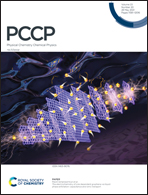Effects of solvation shell relaxation on chain association mechanisms in poly(3-hexylthiophene) solutions†
Abstract
Using poly(3-hexylthiophene) (P3HT) as a model conjugated polymer and atomistic molecular dynamics simulations with carefully verified force fields, we performed in-depth investigations of solvation shell properties of P3HT chains (15 repeating units per chain) in two representative groups of non-polar (or aprotic) organic solvents (better solvents: ortho-dichlorobenzene, bromobenzene, and chlorobenzene; poorer solvents: chloroform, para-xylene, and toluene). We demonstrated that solvation shell relaxation properties in P3HT solutions dictate the formation of regular π–π associations and, hence, crystallinity through the initial chain association and subsequent chain sliding. In contrast, the mean features of polymer–solvent interactions, including solvation free energy and radial distribution function, present little or no difference for all solvent media investigated. Better-solvent media were revealed to bear relatively large values of the first solvation shell relaxation time (τ1 ≫ 100 ps) as well as larger ratios of relaxation times for the first two solvation shells (τ1/τ2 > 2), and vice versa for poorer-solvent media (τ1 ≪ 100 ps and τ1/τ2 < 2). The linear hexyl side-chain unit was noted to substantially enlarge both quantities while notably reducing the solvation free energy as well. As discussed herein, these findings shed new light on the mechanistic features by which solvent quality impacts the degree of π–π association crucial for modern applications with crystalline conjugated polymers.



 Please wait while we load your content...
Please wait while we load your content...